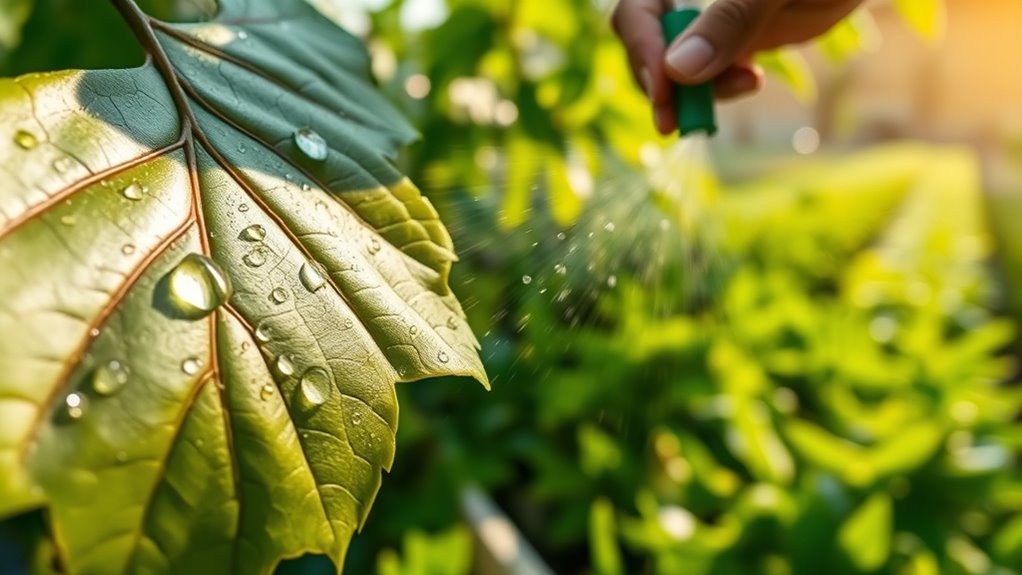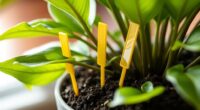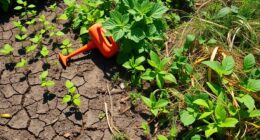Neem oil works by disrupting pest hormones, preventing growth and reproduction. Its key compound, azadirachtin, affects pests internally and externally, acting as both a contact and systemic pesticide. Applying neem oil early morning or late evening allows better absorption and effectiveness. Regular, properly timed treatments maximize pest control while helping prevent resistance. Understanding these modes of action and timing tips can make your pest management more efficient—keep exploring to learn more about optimizing neem oil use.
Key Takeaways
- Neem oil disrupts pest hormonal systems, regulating growth and preventing molting when applied properly.
- Azadirachtin, the active compound, interferes with pest feeding, reproduction, and development.
- Systemic neem oil provides internal plant protection, while contact neem oil creates a protective surface coating.
- Apply early morning or late evening, every 7-14 days during active pest periods for optimal results.
- Environmental factors like temperature and humidity influence neem oil effectiveness and should guide application timing.
How Neem Oil Affects Pest Physiology
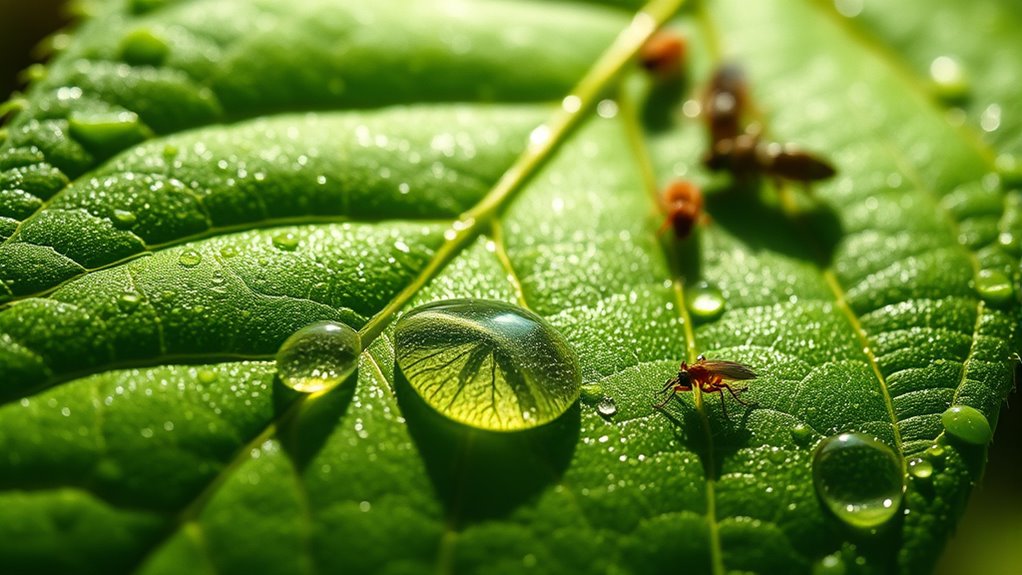
Neem oil disrupts the physiology of pests by interfering with their hormonal systems, which are vital for growth and development. When pests encounter neem oil, it acts as a growth regulator, preventing molting and maturation. Over time, this disruption can lead to pest resistance if used improperly or repeatedly, reducing its effectiveness. However, neem oil stability plays a pivotal role in maintaining its potency; when formulated correctly, it remains effective longer, ensuring consistent pest control. Proper application techniques and rotation with other control methods help prevent pests from developing resistance. Additionally, understanding the modes of action of neem oil allows growers to optimize its use for effective pest management while minimizing the risk of resistance. By understanding how neem oil affects pest physiology, you can optimize its use to manage pests effectively while minimizing the risk of resistance.
The Role of Azadirachtin in Pest Control
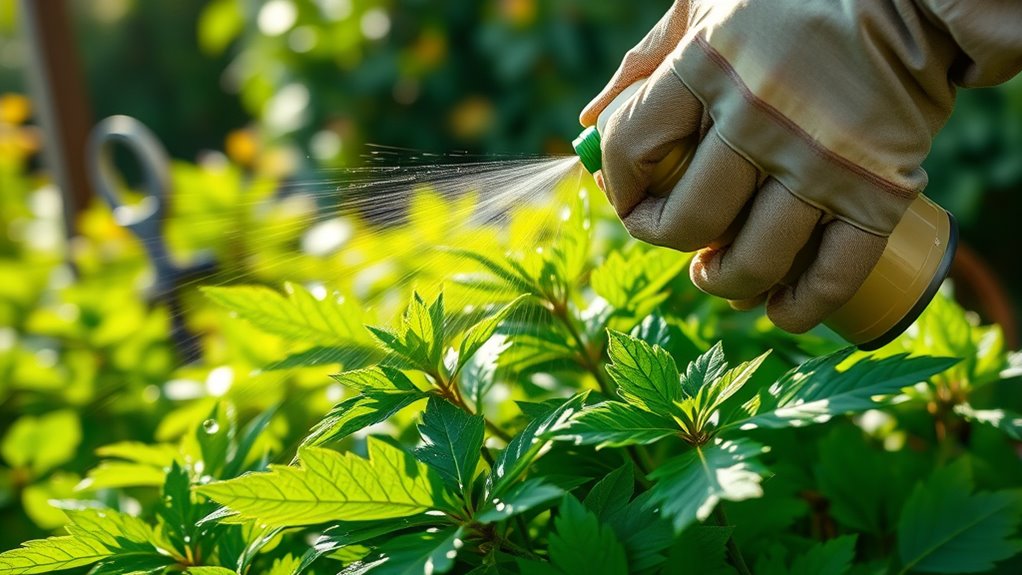
Azadirachtin, the key active compound in neem oil, plays a crucial role in pest control by disrupting the hormonal balance of insects. This compound is responsible for neem oil’s insecticidal properties, making it effective against a wide range of pests. You can extract azadirachtin using various methods, such as solvent extraction or cold pressing, which influence its potency and purity. Once applied, azadirachtin interferes with pest growth, feeding, and reproduction, ultimately reducing pest populations without harming beneficial insects. Its effectiveness depends on the concentration and application timing. By targeting insects’ hormonal systems, azadirachtin provides a natural, environmentally friendly alternative to synthetic pesticides, ensuring your pest management approach remains sustainable and safe. Continuous monitoring of AI Security vulnerabilities can help in developing safer pest control innovations.
Systemic vs. Contact Action of Neem Oil
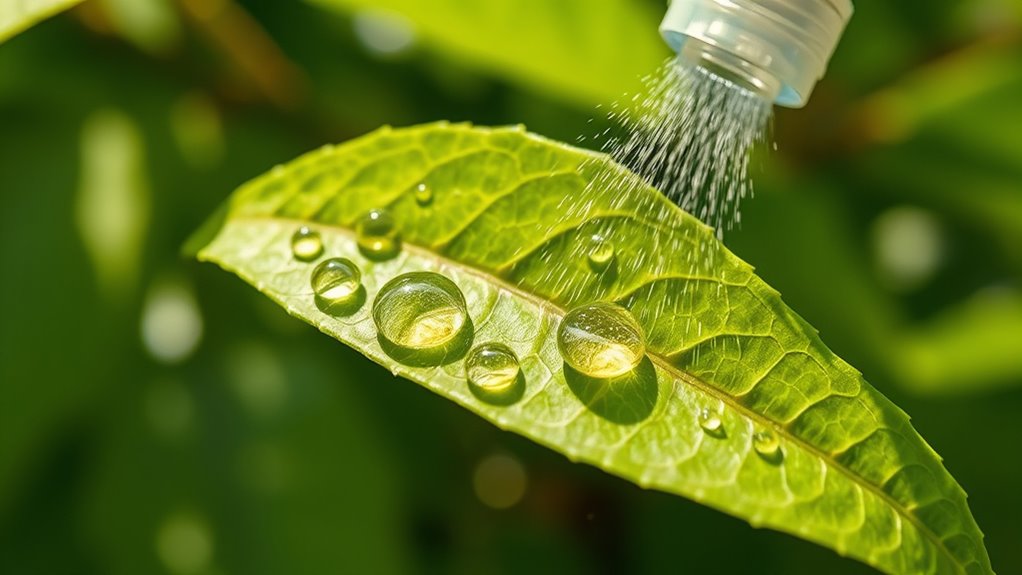
Have you ever wondered how neem oil works differently when applied to plants? Neem oil delivery can be either systemic or contact-based. With systemic action, the oil is absorbed by the plant, providing internal protection against pests. This makes it effective even if pests are hidden inside plant tissues, reducing the chances of pest resistance. Contact action, on the other hand, involves the oil creating a protective coating on the plant surface, targeting pests that land or feed on it directly. While contact neem oil offers quick results, systemic application provides longer-lasting protection. Understanding this distinction helps you choose the right method to maximize pest control and minimize the risk of pests developing resistance to neem oil over time.
Optimal Timing for Applying Neem Oil

Applying neem oil at the right time is essential for maximizing its effectiveness in pest control. To enhance foliar absorption, apply neem oil early in the morning or late in the evening when temperatures are cooler and sunlight is less intense. This prevents rapid evaporation and leaf burn, ensuring better coverage. Stick to a consistent application schedule, typically every 7 to 14 days, especially during active pest periods. Timing your applications before pests become established or during early infestation stages yields the best results. Avoid applying neem oil during midday heat or when rain is forecasted, as these conditions can reduce its efficacy. Proper timing guarantees your plants absorb neem oil effectively, providing ongoing protection against pests. Optimal timing is crucial for effective pest management and plant health.
Factors Influencing the Effectiveness of Neem Oil

The effectiveness of neem oil depends on several factors that influence how well it works against pests. Soil health plays an essential role; healthy soil supports plant vigor, making pests less likely to thrive and respond to treatments. Poor soil conditions can reduce neem oil’s impact. Additionally, application frequency matters—applying neem oil too infrequently allows pests to recover, while excessive use can harm beneficial insects and soil microorganisms. Consistent, well-timed applications ensure better pest control without disrupting the ecosystem. Keep in mind that environmental conditions like temperature, humidity, and sunlight also affect neem oil’s potency. Proper vacuum cleaner maintenance—such as cleaning filters and replacing worn parts—can help ensure optimal performance of equipment used during garden cleanups. By maintaining healthy soil and adjusting your application schedule appropriately, you maximize neem oil’s effectiveness and promote a balanced, pest-resistant garden.
Frequently Asked Questions
Is Neem Oil Safe for Beneficial Insects and Pollinators?
You might wonder if neem oil is safe for beneficial insects and pollinator safety. When used properly, neem oil generally is safe for beneficial insects like bees and pollinators, especially when applied during early morning or late evening when they’re less active. Always follow label instructions and avoid spraying during flowering to protect pollinators. Proper timing and application help make certain you manage pests without harming helpful insects or compromising pollinator safety.
How Long Does Neem Oil Residual Activity Last on Plants?
Ever wondered how long neem oil sticks around on your plants? Residual persistence varies, but generally, neem oil degrades within 7 to 14 days, depending on factors like sunlight, rain, and temperature. Degradation factors such as UV exposure and rainfall speed up breakdown, reducing its effectiveness over time. To maintain pest control, reapply neem oil every 7 to 14 days, adjusting for weather conditions and plant needs.
Can Neem Oil Be Used Indoors Without Harming Household Pets?
You can use neem oil indoors, but you should prioritize indoor safety and pet protection. Neem oil is generally safe for household pets when used correctly, but avoid applying it directly on pets or in areas where they spend a lot of time. Always ventilate well after application and follow label instructions. This way, you minimize risks and guarantee your pets stay safe while protecting your houseplants.
Are There Any Crop Plants That Are Resistant to Neem Oil?
Some crop plants exhibit crop resistance or neem tolerance, meaning they can handle neem oil without damage. You’ll find that plants like tomatoes, peppers, and eggplants often tolerate neem oil well, making them suitable for neem application. However, always test on a small area first, as individual plant responses can vary. Knowing which plants have neem tolerance helps you protect your crops effectively while avoiding potential harm.
How Does Neem Oil Affect Soil Health and Microbial Activity?
Some might worry neem oil harms soil health, but research shows it generally supports a healthy soil microbiome. You’ll find that neem oil can actually boost microbial diversity by controlling pests without disrupting beneficial microbes. When applied properly, neem oil enhances soil resilience rather than depleting microbial activity. So, using neem oil thoughtfully allows you to protect your plants while maintaining a vibrant, balanced soil environment.
Conclusion
Remember, timing is everything when it comes to neem oil. By understanding how it impacts pests and applying it at the right moments, you can effectively protect your plants. Keep in mind that “a stitch in time saves nine,” meaning early intervention prevents bigger problems later. With patience and proper application, you’ll see your garden thrive, free from pests, thanks to neem oil’s natural power.
